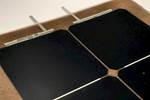LIT Rapid Solar system enhances composite photovoltaic panel assembly potential
Induction-heated thermocompression press developed collaboratively by Roctool and CEA-Liten has verified improvement in temperature and pressure conditions, opening up new opportunities.
Assembly equipment LIT Rapid Solar, developed in partnership with Roctool. Source CEA Laurence Godard
Roctool (Le Bourget du Lac, France) has strengthened its partnership with (Grenoble, France), a company that develops lightweight composite photovoltaic panels for various applications, including solar mobility. CEA-Liten’s laboratories, on the INES site, have been equipped with a thermocompression press featuring an induction heating system. This equipment, LIT Rapid Solar, developed in partnership with Roctool, is reported to offer new and promising features, achieving temperature and pressure conditions that open up new possibilities for photovoltaic module materials.
According to Roctool, LIT Rapid Solar makes it possible to work at much higher temperatures than the lamination equipment normally used for assembling photovoltaic panels — up to 260°C, compared with 180°C. It also ensures cooling in the same chamber, without breaking the applied pressure (applied pressure >6 bar, compared to 1 bar). These temperature and pressure conditions enable the use of novel thermoplastic polymer materials and polymer-matrix composites for the encapsulation step in the module assembly, which in turn could provide opportunities in new sectors and, in particular, facilitate the recycling of these photovoltaic modules.
In addition, the tooling is interchangeable according to the needs of the application. It can be used to achieve flat formats, as well as curved or complex 3D shapes.
Two photovoltaic panels, one made using a standard process, and the other using the LIT Rapid Solar process, passed 100 thermal cycles (-40°C to +85°C) and were tested under high humidity conditions (85°C and 85% relative humidity). Tests have shown that the two modules have equivalent performance, enabling this new process to be pre-qualified in a photovoltaic panel assembly environment.
Related Content
-
Trends fueling the composites recycling movement
Various recycling methods are being considered for composites, from novel dismantling and processing, to building capacity and demonstrating secondary use applications.
-
Plant tour: Hexagon Purus, Kassel, Germany
Fully automated, Industry 4.0 line for hydrogen pressure vessels advances efficiency and versatility in small footprint for next-gen, sustainable composites production.
-
Composites end markets: Energy (2024)
Composites are used widely in oil/gas, wind and other renewable energy applications. Despite market challenges, growth potential and innovation for composites continue.



